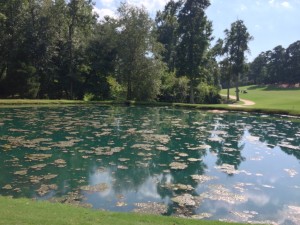Future of Wastewater Treatment: Pond Scum?

A Drexel University study found that a blob of algae taken from a public fountain may be more effective at treating wastewater than many processes currently used by the industry. The study has gained headlines, but it’s important to put the findings in context. The project in its infancy, and the algae is not a solution in itself. As you’ll see, it could improve the efficiency and reduce the cost of traditional wastewater treatment processes by capturing the power of nature.
What Kind of Wastewater can Algae Treat?
Wastewater is a catch-all term that’s used to describe contaminated water, but the study conducted by Drexel University looked at just one kind of wastewater: sewage water, which is typically contaminated by ammonia and excess nitrogen. When nitrogen-rich wastewater finds its way into lakes and rivers, the consequences can be disastrous. In 2015, high nitrogen levels in Lake Erie resulted in the contamination of the entire water supply of Toledo, Ohio. Traditional treatment processes use bacteria to remove nitrogen and ammonia from wastewater, but keeping the bacteria alive is both costly and time consuming. The process developed by Drexel University is beautiful because it uses a natural process to improve wastewater treatment.
How does it differ from Traditional Wastewater Treatment?
Nitrogen-removing bacteria need one key thing to survive: oxygen. While current wastewater processes require added oxygen and added chemicals to keep bacteria alive, the algae creates its own oxygen—like all other plants—with photosynthesis. This is what we call a “symbiotic relationship”: the algae and the bacteria helping one another survive.
Why does it Matter?
The bioreactor developed by Drexel University won’t cause wastewater treatment facilities like AWWT to abandon proven technologies like electrocoagulation that treat water contaminated by radioactive materials, germs and bacteria, oil, or other contaminants. The technology is in its early stages. The promise of algae and “pond scum” is that it’s been shown to remove up to 80 percent of nitrogen from wastewater when used alongside traditional wastewater methods. It could eventually reduce the cost of treating wastewater, both for companies like AWWT and for companies who use our mobile water treatment units. For more information on AWWT, please visit our homepage or contact us today.
The Clear H2O Method

Assess
AWWT conducts preliminary assessments of your systems, facility, and processes to determine productive methods for wastewater removal, management, and treatment.

Control
Through a patented technology, AWWT will implement the most effective treatments based on our investigatory findings and your wastewater management needs.

Safeguard
Collectively we will achieve and maintain “green and clean” solutions through protection and management planning of your future wastewater treatment methods.
Read blog

"San Francisco Wants To Lead The Future In Water And Wastewater Resources"
Few organizations are in a better position to affect our approach to c...Read More >>

"Harvey Leaves Challenges In Texas, From Drinking Water To Rent Payments"
Harvey is finally out of the picture — but the storm's dev...Read More >>

"The Water Cycle"
Earth's water is always in movement, and the natural water cycle, also...Read More >>
